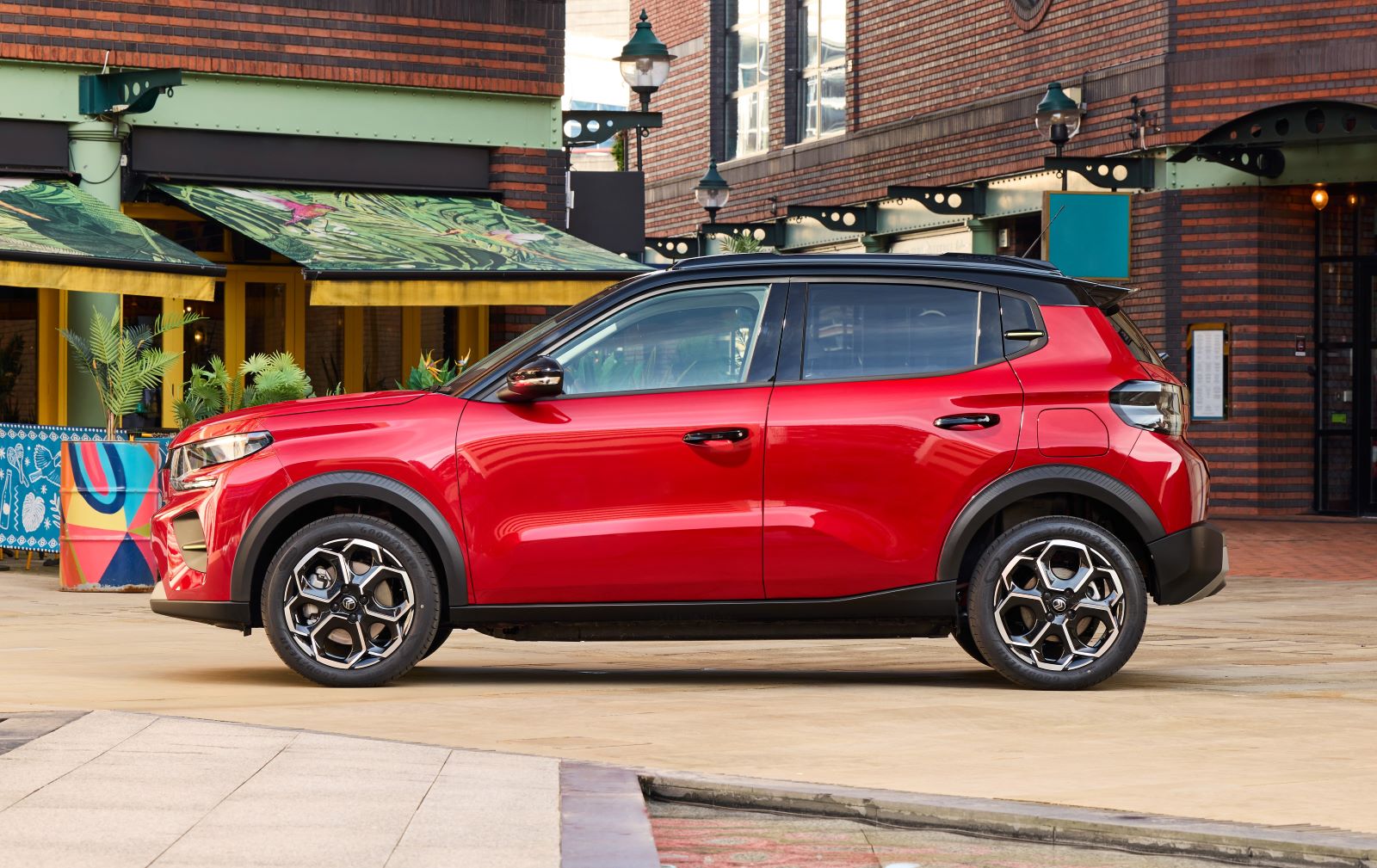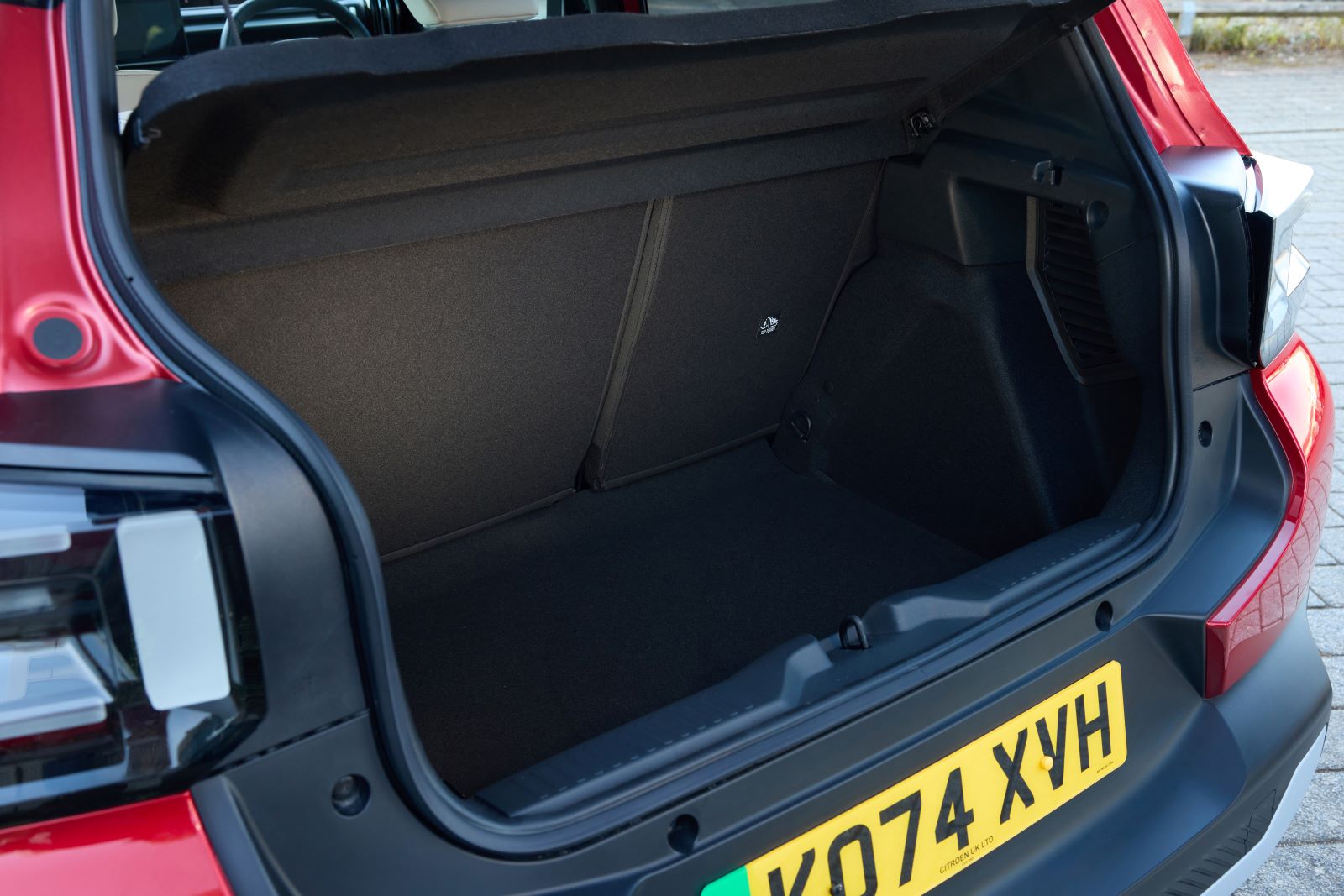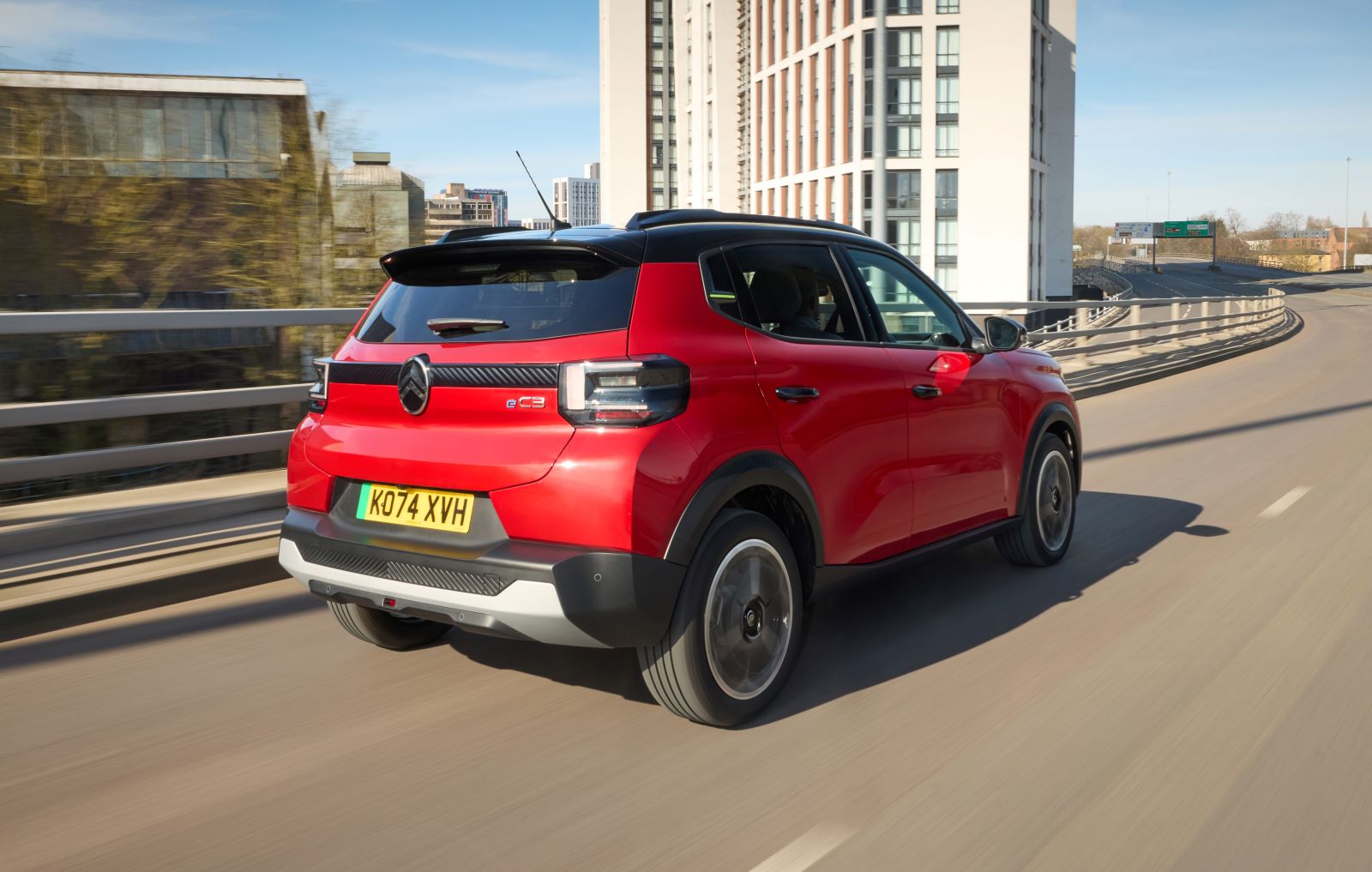
RAC sale – up to 33% off*
• Roadside cover from £5.29 a month†
• We get to most breakdowns in 60 mins or less
• Our patrols fix 4/5 breakdowns on the spot

The Citroen e-C3 is a new budget-focused electric car with plenty of showroom appeal. Lawrence Allan takes an in-depth look.
Things you'll like
- One of the roomiest small EVs
- Decent range on a charge
- Very well priced
Things to consider
- Wallowy handling
- Modest performance
- No Euro NCAP score
What is the Citroen e-C3?
The Citroen e-C3 is the small, affordable electric car than the value-focused French brand should have been building all along.
For years Citroen has offered family-sized EVs – like the Citroen e-C4 and e-Berlingo – and an extremely compromised small ‘car’ in the form of the Citroen Ami.
But after the quirky Citroen C-Zero came and went with limited commercial success, the Stellantis-owned brand never offered its own version of the Vauxhall Corsa Electric and Peugeot e-208. Now, finally, it’s joined the fray.
Pretty much identical inside and out to the latest petrol-powered Citroen C3, the funky-looking e-C3 is closely related to the new Fiat Grande Panda underneath, as well as the larger Citroen e-C3 Aircross and soon-to-arrive Vauxhall Frontera.
Late to arrive, the e-C3 finds itself in a suddenly quite crowded market of low-cost, urban-focused EVs with a usable range on a charge. Everything from the cut-price Leapmotor T03 to the funky Renault 5 offers stiff competition to the e-C3, so how does it stack up?
Verdict: is the Citroen e-C3 a good car?
We reckon the Citroen e-C3 is a good small electric car for those on a tight budget. With a bright and airy cabin, plenty of passenger space and a comfortable and easy driving experience, plus a decent range on a charge, it's a likeable urban-focused EV. It's a shame it doesn't handle or perform as well as the best rivals, though, and the lack of any safety rating will put some off.
Pricing, specs & rivals
Citroen was the first major carmaker to confirm its EVs are approved for the new Government discount via the Electric Car Grant. With the e-C3 receiving the lower ‘band’ two discount of £1,500, that’s a useful chunk of cash of an already affordable model.
With that discount included, the e-C3 starts from a reasonable £20,595. We’ll await clarification of what other alternatives are included in the grant, but currently that undercuts the Renault 5 and is a touch more expensive than the entry-level Hyundai Inster.

Entry-level Plus trim comes with a reasonable kit tally for a budget car including 17-inch alloys, LED headlights, a two-tone roof, manual air-con, rear parking sensors and a touchscreen infotainment system.
With no more powerful electric motor options or bigger batteries, the only way to make your Citroen e-C3 more expensive is via the optional extra list, or by opting for the top-spec Max model. The latter adds £1,700 to the car’s price.
Max trim does add an enticing level of kit, though, including privacy glass, climate control, a rear-view camera, electric rear windows, wireless phone charging, electrically folding and heated rear windows and auto high beam.
Rivals
There are several key competitors for the Citroen e-C3, chief among which are the Hyundai Inster, Renault 5, BYD Dolphin Surf and the e-C3’s sister car, the Fiat Grande Panda.
You might also consider slightly cheaper alternatives such as the Dacia Spring and Leapmotor T03, which are a bit more compromised, while at the other end of the spectrum options that are pricier (at least in list price terms) include the MINI Electric, Mazda MX-30 and Jeep Avenger.
Citroen e-C3: Interior comfort, quality & technology
Bright, airy and pleasant to sit in, the e-C3 avoids the dark and bleak cabin feel some cheap cars are afflicted with. This is particularly true of the Max model, with its coloured seat panels. The split-level dash, with its woven fabric inserts, helps it feel less cheap than it is.
We’d stop short of calling the Citroen’s interior plush – there are plenty of hard plastics on the dash and doors - but it’s good enough for the price. We’re also pleased to see a physical control stack for the climate control on Max versions, too, meaning you don’t have to fiddle with the screen on the move.
Tall side windows and narrow pillars mean good all-round visibility, particularly with the e-C3 offering a higher driving position than most small cars. That also aids getting in and out, while Citroen’s Advanced Comfort seats are squishy yet supportive in the bends.
You’ll find a good level of adjustment in the seats, while the steering wheel adjusts up, down, in and out (some small cars only let you adjust the wheel up and down). We just wish the wheel could be brought closer to the driver, because those with long legs will find it trickier to get comfortable behind the wheel.

Infotainment, sat-nav, stereo and connectivity
Both versions of the e-C3 have a 10.3in touchscreen infotainment system mounted within your line of sight in the dash. Only the Max version has integrated sat-nav, but all have Apple CarPlay and Android Auto smartphone mirroring.
It’s a basic system with little surprise and delight, feeling a lot less sophisticated than the system in the Renault 5 or Hyundai Inster. But the trade-off is it’s simple to use and avoids excessive menus. That’s great, but it can take a while to respond to inputs.
Every version also has what Citroen cheekily calls a ‘head-up display’. Rather than an image projected onto the windscreen, it’s simply the brand’s name for the instrument display, which sits high up on the dash. You look over the wheel at it rather than through it, which will feel unusual for some, but unlike in some Peugeots most drivers won’t obscure the display with the steering wheel.
In terms of connectivity, you’ll find two USB-Cs up front (annoyingly mounted in odd places on the dash, away from the phone storage tray) and a single on in the rear alongside a 12-volt socket. Wireless charging only features on Max models.
The six-speaker audio system delivers acceptable sound quality by the standards of cheap cars – it’s certainly a lot better than the tinny speakers in a Dacia Spring or Leapmotor T03.
How practical is the Citroen e-C3?
One of the Citroen e-C3’s biggest selling points over similarly priced (but usually smaller) EV rivals is the space on offer.
The e-C3’s dimensions of 4,015mm in length, 1,755mm in width and 1,577mm in height makes it longer and wider than the BYD Dolphin Surf, Leapmotor T03 and Hyundai Inster. It’s also slightly longer and considerably taller than the Renault 5.
As a result, you’ll find plenty of head and legroom for taller passengers up front, as well as enough cabin width to reduce the likelihood of you banging elbows with your front seat passenger.
In the rear you’ll also find more headroom than a Dolphin Surf, and noticeably more legroom than the Renault 5 – enough of both for six-footers to get reasonably comfortable. It’s an airy place to sit too thanks to large windows – our only minor gripe is that your knees sit higher than is ideally comfortable due to the batteries pushing up the height of the floor, but that’s something common with many EVs.
You also get three seats in the rear rather than the strict two seats in several rivals, although you’ll struggle to fit three adults across the bench itself in enough comfort for long journeys (it’s better suited to children old enough to be out of a car seat).
Granted, a Hyundai Inster can be made roomier still for two in the back thanks to its clever sliding and reclining rear seats, but that car forces you to choose between boot space and passenger room.
Storage and boot space
There is a good amount of storage in the e-C3 including deep door bins, a cubby under the centre armrest, a pair of cupholders, a good-sized glovebox and various trays for your wallet and keys.
In the rear the door bins are a smaller size, but still take small water bottles, while you also get large pockets in the front seatbacks along with smaller ones at the top of the seat for passengers to stick their phones in. You don’t get a central armrest, though that’s the same for most small EVs.
The e-C3’s 310-litre boot is a decent size, and although its outright capacity is smaller than some rivals it’s a more usable space than in the Renault 5. It’s a shame, though, that there’s no adjustable boot floor so there’s a large load lip to lug items over, and your charging cables have to sit within the boot.
When you fold the seats down (which you can do in a 60/40 split) you also don’t have a flat floor at the other end, meaning you must lug heavy items up and over the folded seats.

Performance & drive: What is the Citroen e-C3 like on the road?
Used to electric cars offering neck-snapping performance? You won’t get anything of the sort in the Citroen e-C3. You see, while 112hp is a decent amount for a petrol-powered small car, it’s modest for a heavier electric car.
As the pedestrian 0-62mph time suggests, then, the e-C3 won’t win many outright sprints. But that doesn’t mean it feels sluggish. Although full power is gently metered out at low speeds to avoid wheelspin, the little Citroen gets from 30 to 60mph reasonably quickly and doesn’t feel too out of its depth at motorways speeds.
It’s way faster than a Dacia Spring and peppier than the Leapmotor T03, while being on a par with the Long Range Hyundai Inster. However, all versions of the Renault 5 are noticeably quicker.
The e-C3’s brake pedal feels quite natural to press, with less of a grabby feel than some EVs. You don’t get adjustable regenerative braking, though, which is a shame. Instead of a ‘B’ mode by the drive selector like most EVs, you merely get a ‘C’ mode – which just dulls the throttle response.
Power, 0-62mph times
- Citroen e-C3 (all models): 112hp/ 11 seconds
Ride and handling
As the e-C3’s performance figures suggest, this is no sports car. And the handling reflects that, with lots of body roll making the Citroen feel quite wallowy. The steering isn’t great, either; it’s accurate enough, but slow to react to inputs as well as being light and lifeless. At least there’s plenty of grip.
The e-c3 is better suited to gentler driving, where it excels thanks to its soft suspension ironing out lumps and bumps in the road. It means speed bumps and potholes are no bother around town, even if the Citroen feels less composed and bouncier on faster roads.
Overall, the Citroen e-C3 is a bit more comfortable than the BYD Dolphin Surf and Hyundai Inster, but can’t match the Renault 5 for all-round composure at any speed.
Noise and refinement
For a car that isn’t exactly purpose-built for spending long periods on motorway, the Citroen e-C3 is respectably quiet at 70mph. Tyre noise is less noticeable than it is in the Renault 5, and while wind noise is clearly heard it isn’t intrusive by any means. The electric motor emits a bit of a whine if you floor the throttle, but again it isn’t unpleasant.

Euro NCAP: is the Citroen e-C3 a safe car?
Unfortunately, Euro NCAP has yet to put the e-C3 through its crash test regime, meaning we don’t have an official safety score to go on.
All we can say so far is that is has six airbags (the expected amount for all new cars) plus the safety assists legally mandated for EU countries including automatic emergency braking, lane keep assistance, traffic sign recognition that warns if you’re exceeding the speed limit and a driver attention monitor.
Citroen also gives you handy shortcut buttons for turning the speed warning and lane assist off if it’s not wanted, too, taking a leaf out of Renault’s book.
It’s a shame that we can’t compare the e-C3’s crash performance directly with alternatives such as the Hyundai Inster and Renault 5 – both of which managed a respectable four stars out of five in Euro NCAP tests.
Charging, range and running costs
Citroen has clearly targeted the e-C3 at town dwellers, but the range on a charge isn’t as restrictive as urban-focused EVs would’ve been only a few years ago.
All e-C3s feature a 44kWh battery pack with an impressive usable capacity of 43.8kWh. It’s only around 10% smaller than the pack on larger, more expensive Stellantis models, such as Citroen’s own e-C4.
However, range takes a hit when compared to models like the Vauxhall Corsa Electric, which thanks to a recent software-based efficiency now boasts an official 266 miles on a charge. The e-C3 manages a less impressive 199 miles under the official WLTP test regime.
In our experience the e-C3’s efficiency is hampered most by motorway speeds. Keeping to roads with speeds of 50mph or below makes it possible to achieve or even beat that figure.
By comparison, the e-C3’s range is slightly ahead of the entry-level Renault 5 and on a par with the longest-range Fiat 500e. It also just about matches the 43kWh BYD Dolphin Surf and is only slightly behind the 39kWh Hyundai Inster.
Range on a charge (WLTP figures)
- Citroen e-C3 (all versions): 199 miles
Just as with the range on a charge, the Citroen e-C3’s charging speeds are competitive with similarly priced rivals.
Peak DC rapid charging speeds of 100kW on both versions allows a 10-80% charge time of just over 30 minutes according to EV database, which pegs the average figure at a more modest 60kW. A Peugeot e-208 will charge slightly quicker in real-world situations, but not by much, and the Citroen is in line with cars like the Renault 5.
Where the e-C3 falls behind slightly is with AC home or destination charging. As standard all models have a 7.4kW on-board charger; you’ll need to pay a few hundred quid to get a three-phase 11kW one. Several alternatives, such as the Renault 5, have this as standard.
Bear in mind, though, that most home chargers can only output 7.4kW anyway, so that’ll only be an issue if you frequently use AC destination chargers that can hit faster speeds.
Charging speeds
(Figures from EV Database)
- 7kW charging: 7hrs
- 11kW charging: 4hrs 45 minutes (with optional 11kW charger fitted)
- 50kW rapid charger (10 to 80% charge): 48 mins
- 150kW+ rapid charger (10 to 80% charge): 32 mins
How much does the Citroen e-C3 cost to insure?
The Citroen e-C3 sits in insurance group 24 regardless of which trim level you opt for. That’s a little disappointing for a budget-focused, modestly powered EV, particularly when the faster Renault 5 starts from group 19 and the BYD Dolphin Surf starts from just group 14.
Citroen e-C3 FAQs
Is the Citroen e-C3 worth buying?
Yes, we reckon the Citroen e-C3 is a good small electric car that’s well worth considering. It’s stylish, airy and spacious inside and comes with a good level of standard equipment for a budget option. It’s also comfortable, but rivals are faster and handle better.
What is the range of the Citroen e-C3?
The Citroen e-C3 has a range of 199 miles on a full charge according to official WLTP tests. The range you will achieve in the real world varies depending on your driving style, speed and the weather.
What is the Citroen e-C3’s insurance group?
The Citroen e-C3 sits in insurance group 24 regardless of trim level, which is higher than a number of small electric cars including the Renault 5 and BYD Dolphin Surf.













